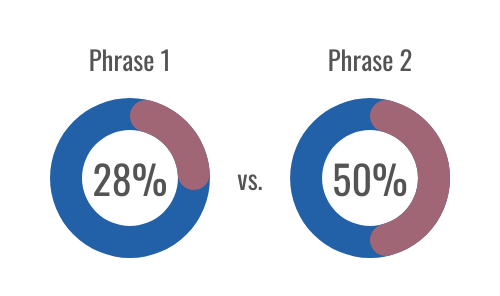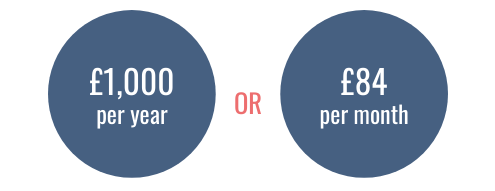Understanding Consumer Behaviour
Us humans are fickle beings. When it comes to buying something, we’re always after a bargain and want to get the maximum amount of product for our money. This can be a problem for sales people, but, like we’ve just said, humans are fickle, therefore, making some minor changes to the way we sell can make a big difference between a buyer saying ‘Yes’ or ‘No’.
Less is More
Research has shown that making subtle differences to your language can make a huge difference between a consumer saying yes or no. In a study carried out by Psychologist Dr. Robert Cialdini, he asked door-to-door donation requesters to ask people one of the two phrases:
1. “Would you be willing to help by giving a donation?’
2. “Would you be willing to help by giving a donation? Every penny will help.”
The study found that people who were asked the second phrase were almost twice as likely to donate compared to people that were asked the first phrase. By adding the “every penny will help”, it makes the request more achievable in the donators eyes. Funnily enough, even though asking the second question increased the likelihood of donation, the statement asked made no difference to the amount of money respondents donated.
T2 Takeaway: implying that a small action is a good start will make people more amenable to making a move. To help the consumer break through ‘action paralysis’, identify a minimum order amount to help sway their final decision.
Embrace the Power of Labels
Us humans are social creatures; we like to feel a part of something and a crave for a sense of belonging. Research has shown that even just being told that we’re part of a group makes us more receptive to its message. Therefore, customer loyalty programmes that label their customers as ‘gold’ or platinum’ are effective in getting customers to spend more.
T2 Takeaway: don’t be afraid to label your customers. People like to feel a part of something and tend to take more action in order to feel like they belong to an ‘elite’ group of people.
The 3 Types of Buyers
No matter the industry you work in, consumer spending habits can be categorised into 3 groups. These groups are characterised by the ‘pain’ the buyer can tolerate when purchasing something. Neuroscientists explain human spending patterns as a process of “spend it till it hurts”, or in other words, the point in which you grimace when the cashier announces how much your weekly food shop is.
Unconflicted: Average spenders
Spendthrifts: people who are able to spend more before they hit their maximum buying pain.
Tightwads: people who spend less than average before they hit their maximum buying pain.
As you would assume, the ‘tightwads’ are the hardest type of consumer to convert, and as 24% of customers are in fact, ‘tightwads’, organisations need to come up with ways to get them spending! Luckily, neuroscientists have come up with 3 simple strategies that will minimise their (and everyone else’s) buying pain.
1. Reframing Value
Which one would you rather pay? The first one looks a a bit daunting doesn’t it? However, those of you who are particularly good at maths will know that £84 per month, is pretty much equivalent to £1,000 per year. The reframing method is effective for buyers of all types, but is most effective at encouraging the more conservative spenders amongst us. If you offer a service or product that can be broken down into smaller increments or has a recurring cost, be sure to include the price breakdown information in your pricing model.
2. Bundling
Research tells us that all consumers prefer to complete any purchase in a bundle, rather than purchase multiple accessories separately. This is because individual purchases mean individual pain points; whereas a bundle purchase creates just 1 pain point, even though the overall price might be greater.
Take buying a car for example. You decide on a car, tell the salesperson you want to buy it, and then they take you inside where they try and sell you all the add-ons.
Now, the sales person can do one of two things:
*disclaimer: please excuse the lack of knowledge on car add-on prices/accessories you are about to read.
Option 1: They can go through each individual add-on and list the price of each, e.g.
Heated steering wheel - £100
Alloyed wheels - £300
Heated seats - £150
Chip-free paint - £120
Or
Option 2: They can list all the add-ons and provide the customer with a ‘bundle price’ at the end.
The customer is much more likely to purchase the add-ons if the salesperson bundles them together; because not only is it less hassle, but it’s also fewer pain points!
3. One word can make all the difference
Carnegie Mellon University carried out a study that demonstrated the impact of a single word on conversion rates. Researchers changed the description on a shipping charge for a free DVD trial offer from ‘a £3 fee’ to ‘a small £3 fee’, and it increased the response rate by a huge 20%.
Ridiculous right? With a single word making that big of a difference to conversion rates, it just shows that the devil is in the detail when it comes to designing your sales promotions!
T2 Takeaway: no matter what industry you’re in, understanding the 3 types of buyers and what can influence their consumer behaviour can put you ahead of the competition. With tightwads taking up almost a quarter of consumers, it’s worth considering adopting at least one of three strategies above.
In summary: in this blog post, we’ve provided you with a few simple, yet very effective ways you can try to increase buyer conversion rates. By understanding certain aspects of consumer behaviour, and adapting your sales strategies, you can potentially see a huge difference in your customer buying habits.






